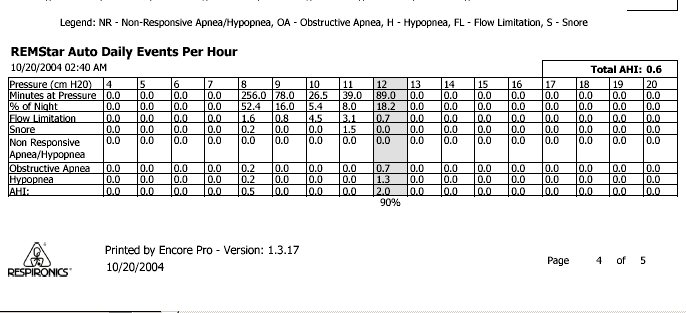hi hhunt,
You wrote:
12.4 is what the autopap "clocked" me at 95% of the time for the 12 nights that I wore it in my own home from the DME, that is how she figured my pressure for the cpap machine.
hhunt, as Wader said, the 95% pressure number doesn't mean the autopap was blowing that pressure at you most of the night. If the doctor or DME had you doing a 12 day trial on autopap with the
intention of finding a
single pressure that takes care of you, and intended to put you on straight cpap after the autopap finds the highest pressure you might need...that's one thing. Yes, then the figure the software states as the "95% pressure" is useful to know.
On an autopap, I think of it this way:
"It took pressures of 12.4
or below to prevent and/or deal with events 95% of the time I was sleeping."
Why does it make a difference which way you look at it? Well, if a person is going to be receiving a straight cpap to be set at one pressure blowing at them all night, they do want to set that single pressure to be high enough to take care of you most of the time.
However, if a person wants the comfort of sleeping with
less pressure
until 10, or 11, or 12.4 is actually needed during the night, then an autopap is a better choice.
When considering whether an autopap or a straight cpap would suit you, you'd need to look at
each night's data instead of looking at a single "95%" number from 12 nights all lumped together. Look at each of the twelve nights and look at
how many minutes of your sleep were spent at each of the pressures used during those individual nights.
You might be surprised to see that very little time was really spent up at 12.4 and a lot more time was spent down at varying lower pressures.
Example: here's a chart from my Respironics REMstar auto for a single night.

You'll see that the chart highlights the column for the pressure of 12 and labels that the
"90 %" pressure.
But....look on the chart at the amount of time spent sleeping at pressures
lower than 12 during that eight hour sleep session.
Minutes at pressure 12: 89 minutes
Minutes at pressure 11: 39 minutes
Minutes at pressure 10: 26.5 minutes
Minutes at pressure 9: 78 minutes
Minutes at pressure 8:
256 minutes
Much more than half my entire night was spent at several pressures
below the "90% pressure". In fact, better than half the night was spent down at the lowest pressure ( 8 ) that I had set the machine's range for (8-16). That's true of every night I ever look at -
much more time is spent well
below the "90% pressure" on my autopap.
The less time one must spend up at a single high pressure, the less chance for springing mask leaks, swallowing air, having trouble exhaling, etc. I'd much rather spend as much time as possible at lower pressures, than have a steady blast of a single high pressure all night long. Especially if it's a pressure that I
don't even need most of the time while I'm sleeping.
It makes no difference to me who uses cpap and who uses autopap, or bipap...whatever. I have no reason to push anyone toward "autopap" other than autopap simply gives a more comfortable treatment for many people, imho. People can do fine on straight cpap, too. As long as I have my autopap, I'm happy.
I've gone on and on at length about this, simply because I'd be very sorry to see people misinterpret what a DME says about what the "90% or 95%" pressure and think it meant a trial autopap had been using that particular high pressure almost constantly while they slept.
I also think there is a bit of misconception (perhaps on my part!) if someone thinks that autopaps are designed only to
react to events. I don't think putt-putting along and simply waiting for apneas or hypopneas to happen before the autopap jumps into action is how they work. Certainly an event can sneak by occasionally, but my understanding is that the autopap is almost constantly "reading" the person's breathing and making smooth
proactive pressure moves to
prevent the throat from closing and
prevent most events from happening at all.
I'm not a doctor or health care professional. Just my opinion.
